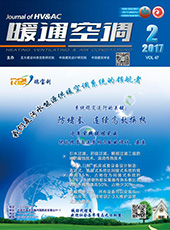| if this email does not display properly, please see online version. please add to your address, to avoid to block by spam-blocking software |
|
February 2017 Vol.47 No.22 |
 |
| This issue contains the second part of "HVAC for Nuclear Power" Column followed to November issue in 2016. Supported by national policies, the third generation nuclear power technologies have matured and deployed, including AP 1000/CAP 1400 and Hualong No.1, and the fourth generation technology representing by high temperature gas cooled reactor is developing as well, which driving China to leap from "Made in China" to "Design in China". |
| • Iodine adsorber application to ventilation system of nuclear power plants • Practicability analysis of steam LiBr chiller for nuclear island • Research and product development of anti-freezing capability of nuclear heat exchangers |
| Identified by "2016 Coal-to-clean energy Program for Rural Area in Beijing", Beijing will complete the clean energy retrofittings of 300 000 coal-to-electricity projects and 100 000 coal-to-gas projects in 2016-2018. More than 1 500 gas-fired heating boilers in Beijing will be replaced as the requirements before heating period of 2017. Beijing will move forward to a new development pattern of building and environment efficiency. |
| Updated schedule for 2017 events organized by Journal of HV&AC: April 20th - 21st • 2017 HVAC engineering design conference: Difficulties and case studies on hospital • 9th Retrofitting technologies conference for existing buildings: Efficiency retrofittings • 9th Retrofitting technologies conference for existing buildings: Indoor air quality and healthy buildings May • Sino Germany forum on green buildings May 11th • 3rd New technologies forum on data centers air conditioning systems May 25-26th • 5th International forum on environmental control technologies for science laboratories July 6th • 2017 HVAC engineering design conference: Airport terminals September • Hospital HVAC system operation and supervision seminar October • Efficiency retrofitting technologies forum on subway air conditioning systems November • 3rd Green building design and operation technologies conference December • 1st Youth Forum | 2016 China HVAC market reached over 70 billion RMB The China HVAC market capacity in 2016 was increased by 10%, reaching far more 70 billion RMB after slashing in 2015. The increase drivers of 2016 market were the F-gas products, including multi splits and unitary units, especially multi splits with over 20% of growth rate and 40% of market share as the leader. Middle and small projects representing by hospitals, schools, shopping departments and restaurants played the significant roles, which preferred to multi splits, unitary and modular products. 1.1 Billion SQMs of new geothermal heating and cooling areas in China’s 13th Five-year "Geothermal energy development and utilization program in 13th Five-year Plan" identifies that new geothermal energy heating and cooling areas should reach 1.1 billion SQMs and new geothermal power generation installation capacity should be 500 MW by the end of 13th Five-year Plan. By 2020, the accumulative heating and cooling areas and generation installation capacity will be 1.6 billion SQMs and 530 MW, respectively. As estimated, during the period of 13th Five-year Plan, the investments driven by shallow geothermal heating and cooling, hot water geothermal heating and geothermal power generation will be 140 billion RMB, 80 billion RMB and 40 billion RMB, respectively. What policy changes will shape HVAC&R industry in 2017? 2017 is set to be an interesting year, with implementation of the Kigali Agreement and new standards for natural refrigerants on the agenda. 2016 was a monumental year for energy and climate change policy worldwide. In 2017 policymakers will begin to implement the Kigali Agreement on phasing down HFCs and the Paris Agreement on climate change, as well as assessing refrigerant standards. |
| Advertisement/contact: zhanglh@cadg.cn | ||
| Copyright©2017 | Help center | About us |
